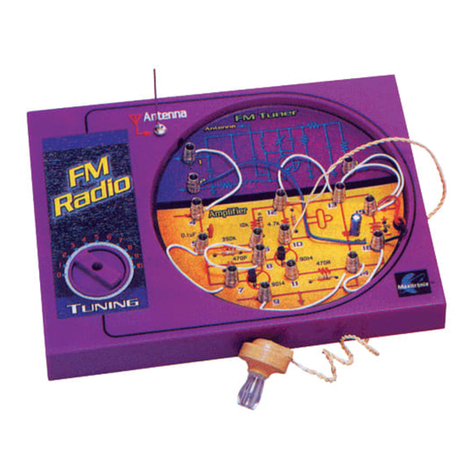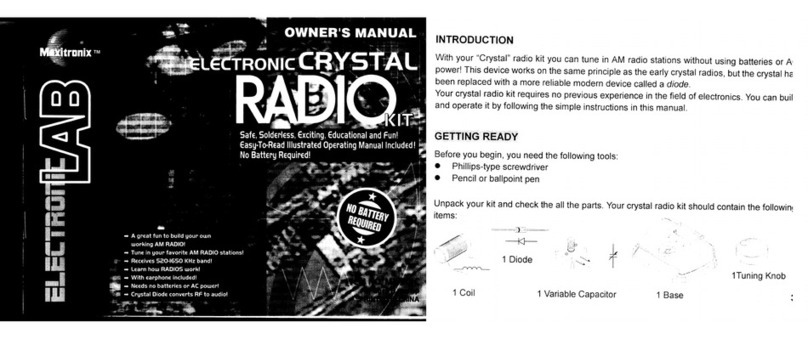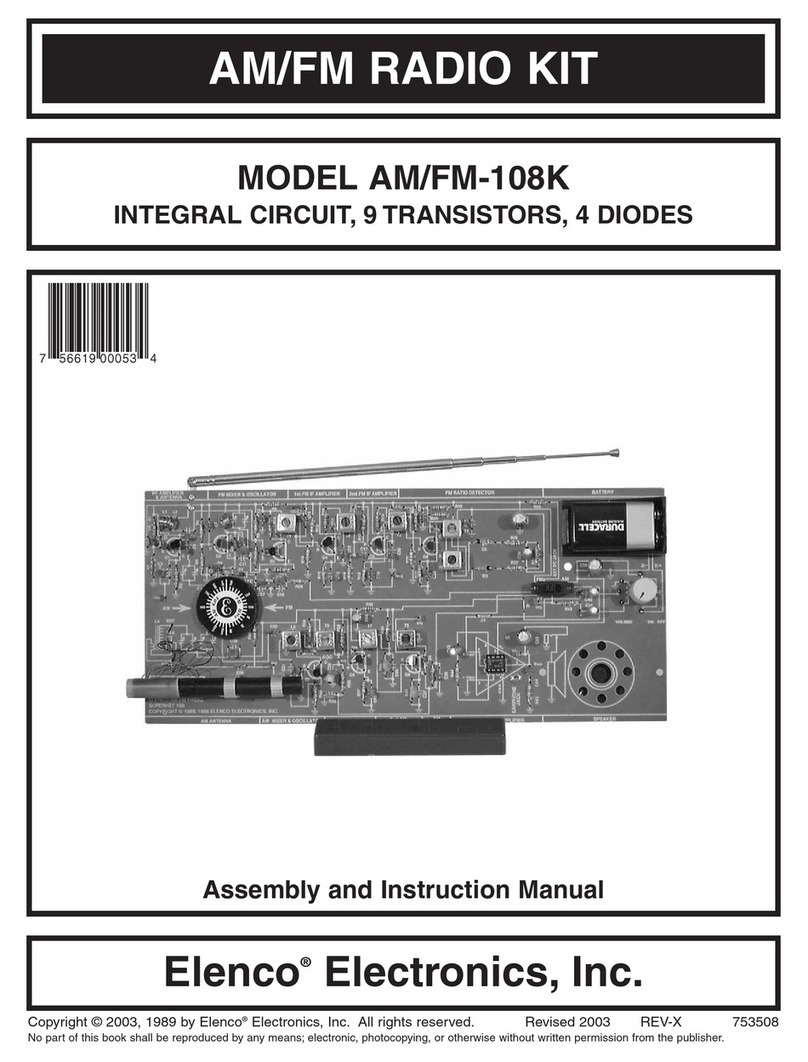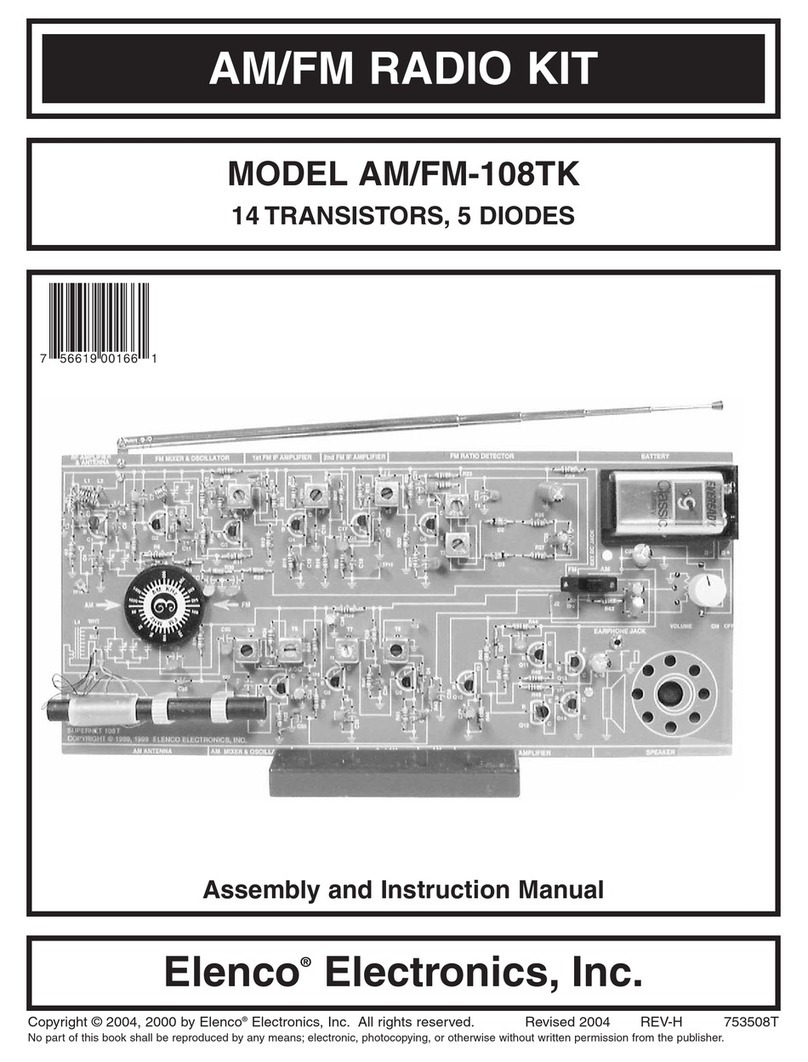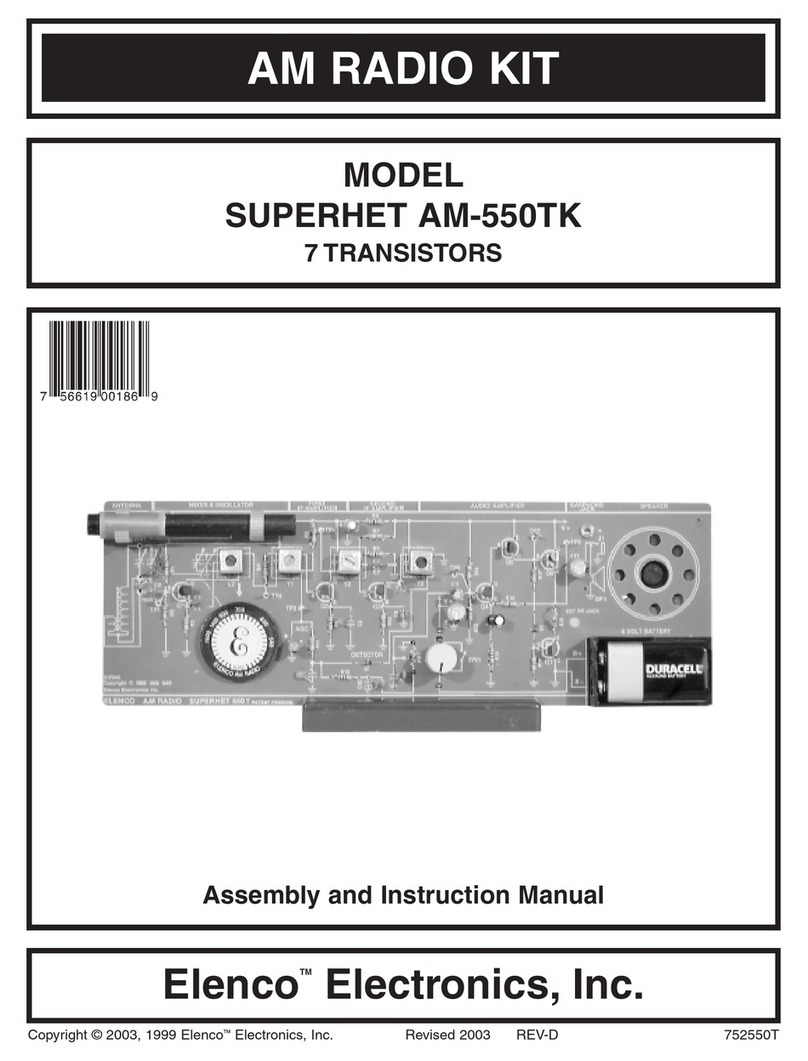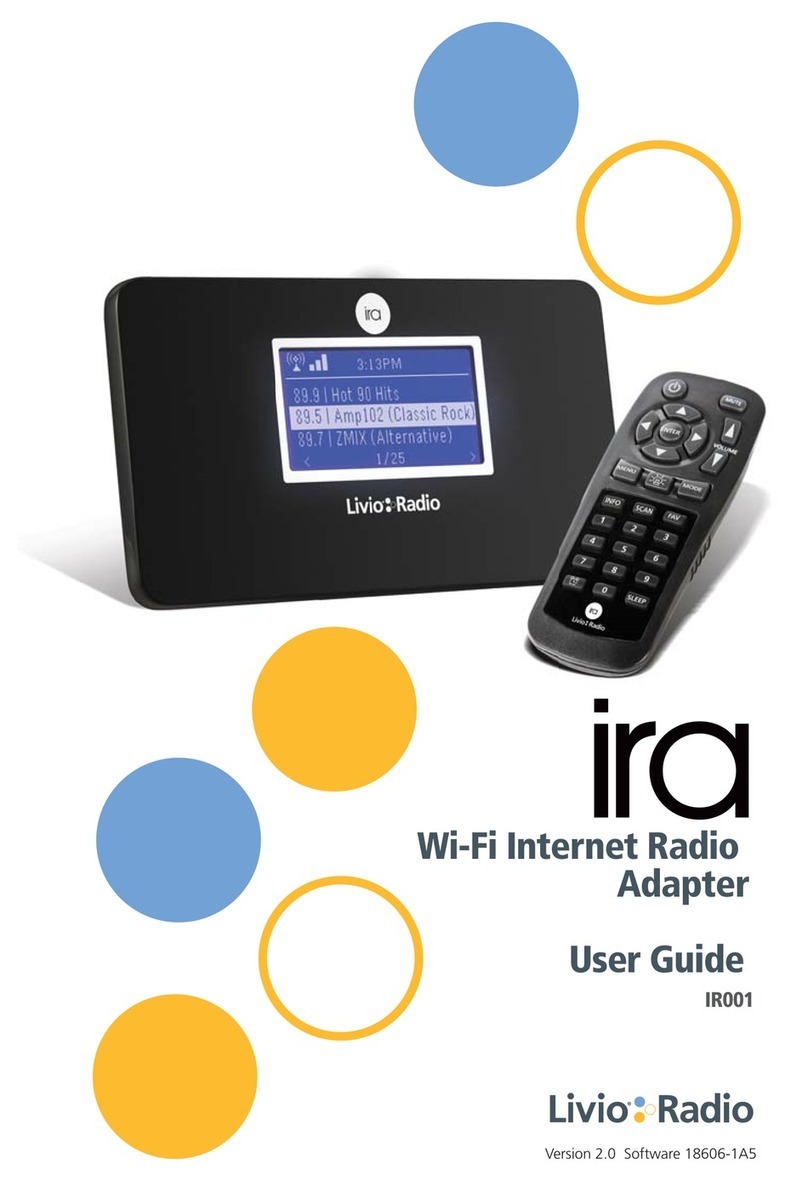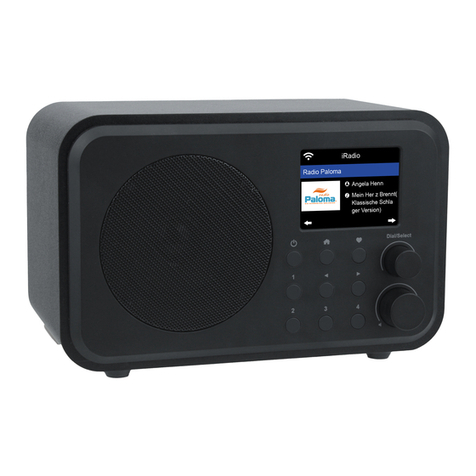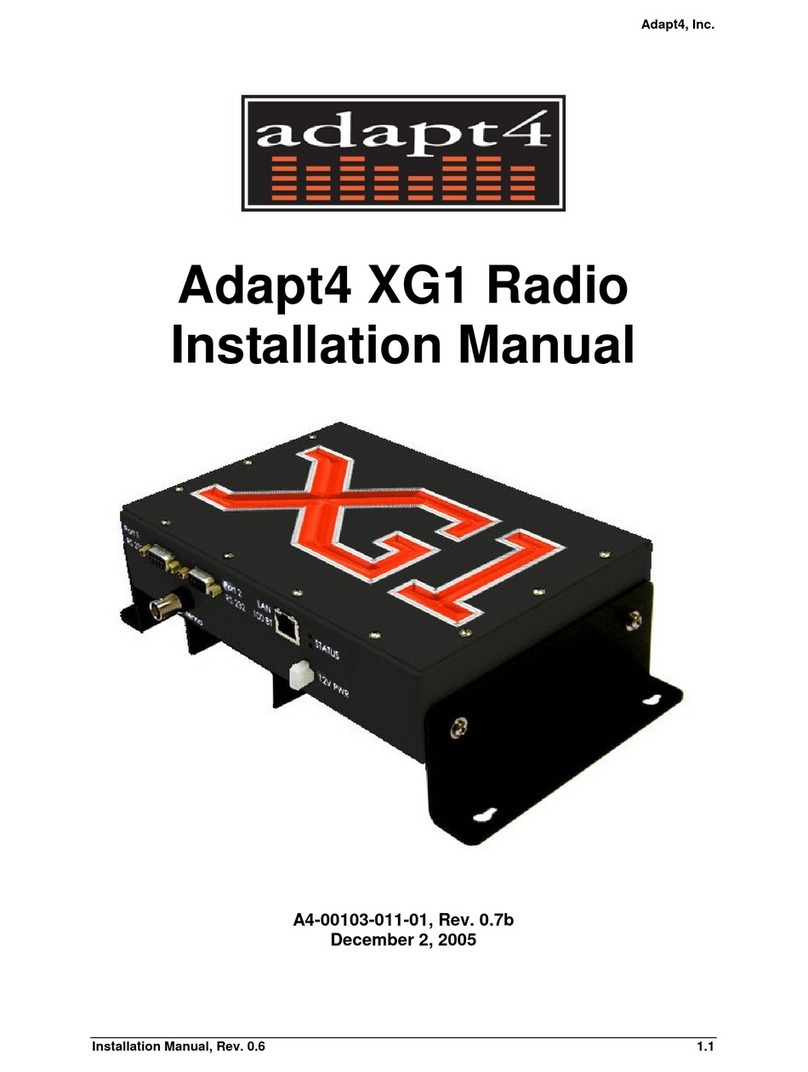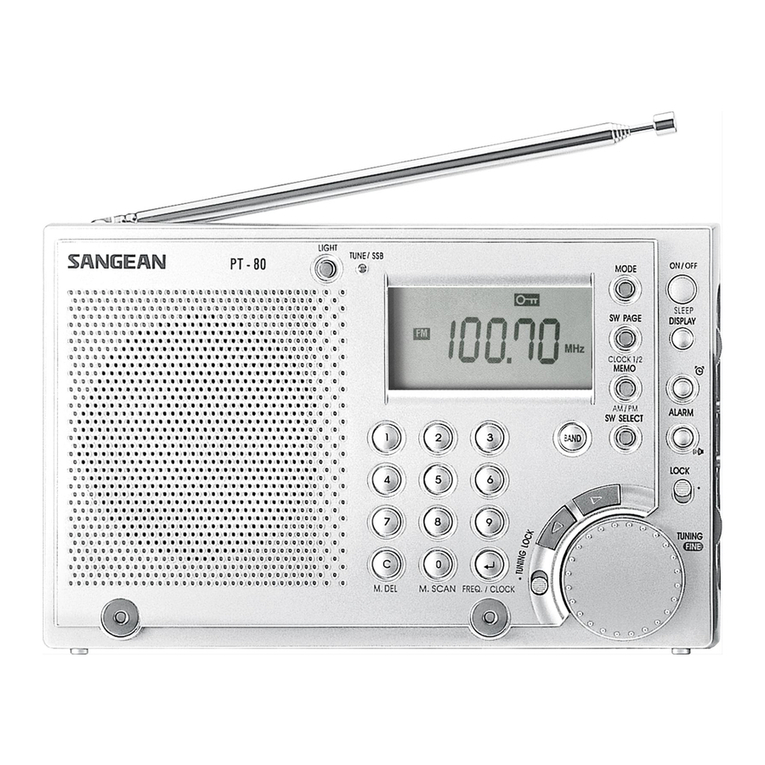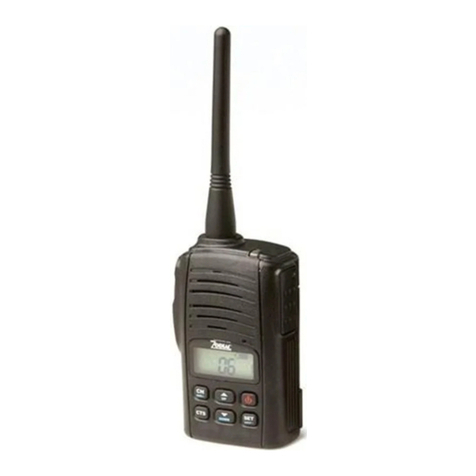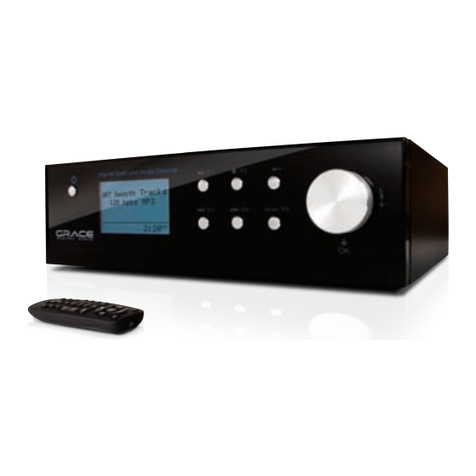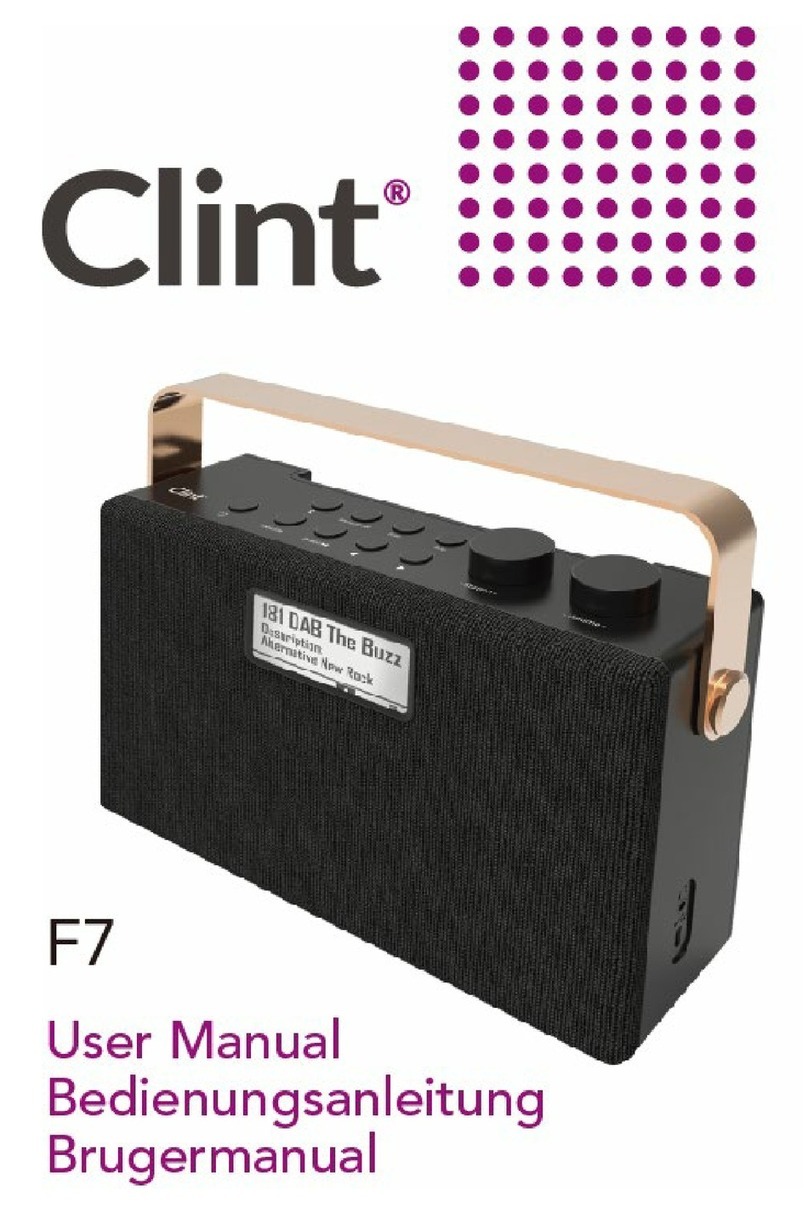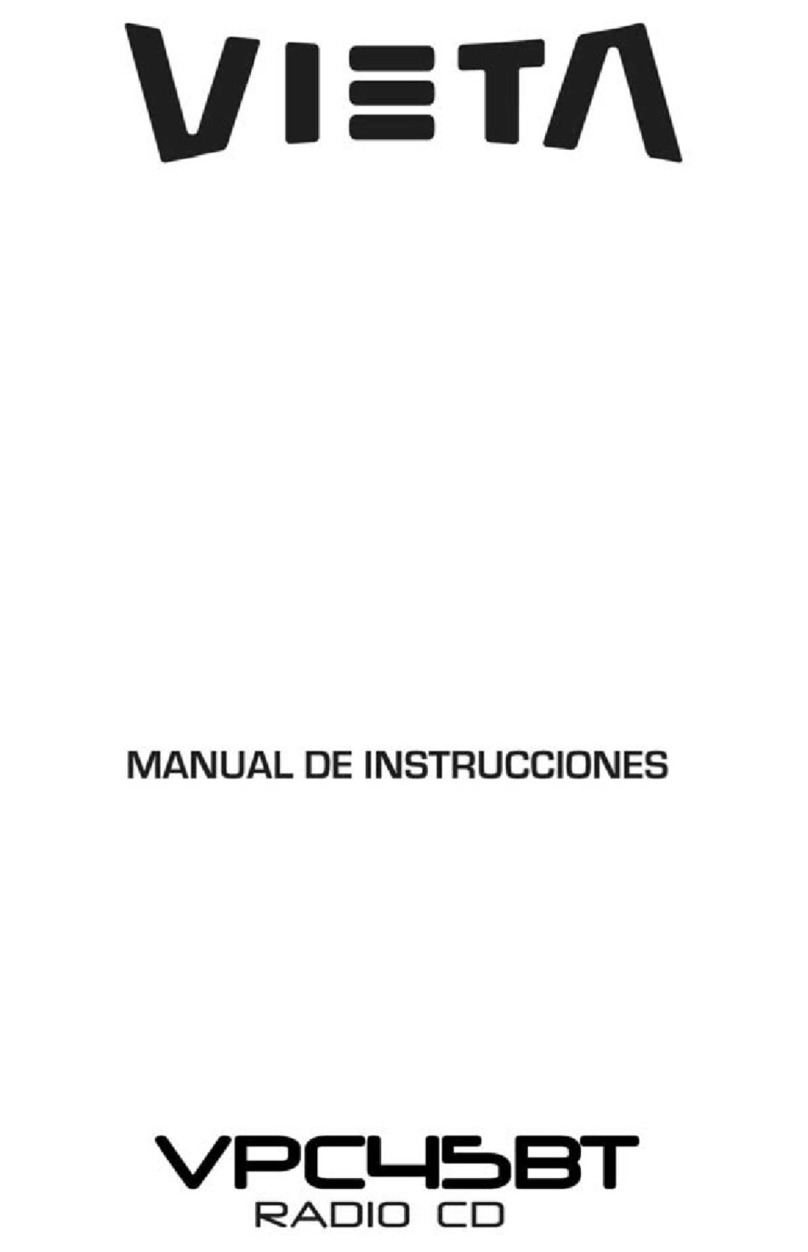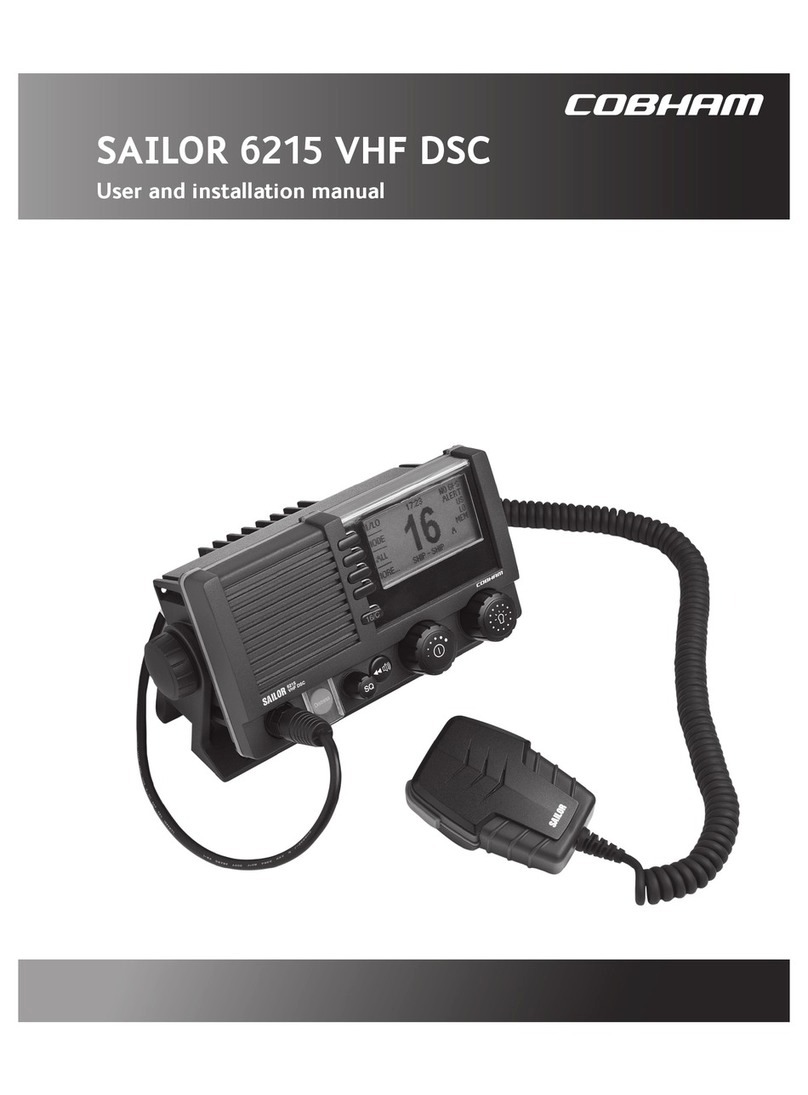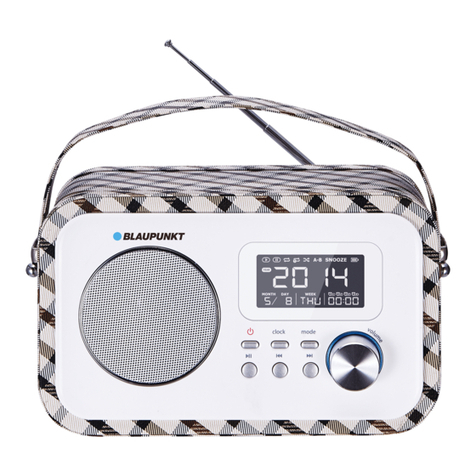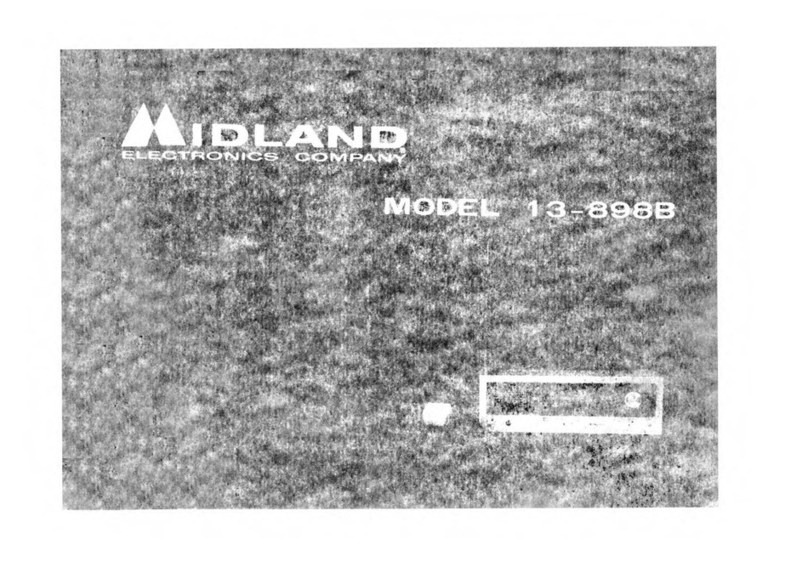Elenco Electronics AM/FM-108CK User guide

AM/FM RADIO KIT
MODEL AM/FM-108CK SUPERHET RADIO
CONTAINS TWO SEPARATE AUDIO SYSTEMS:
IC AND TRANSISTOR
ELENCO®
Copyright © 2012 by ELENCO®All rights reserved. 753510
No part of this book shall be reproduced by any means; electronic, photocopying, or otherwise without written permission from the publisher.
Assembly and Instruction Manual

-1-
The AM/FM Radio project is divided into two parts, the AM Radio Section and the FM Radio Section. At this
time, only identify the parts that you will need for the AM radio as listed below. DO NOT OPEN the bags listed
for the FM radio. A separate parts list will be shown for the FM radio after you have completed the AM radio.
PARTS LIST FOR THE AM RADIO SECTION
If you are a student, and any parts are missing or damaged, please see instructor or bookstore.
If you purchased this kit from a distributor, catalog, etc., please contact ELENCO®(address/phone/e-mail is at
the back of this manual) for additional assistance, if needed. DO NOT contact your place of purchase as they
will not be able to help you.
RESISTORS
Qty. Symbol Value Color Code Part #
r1 R45 10Ω5% 1/4W brown-black-black-gold 121000
r2 R44, 48 47Ω5% 1/4W yellow-violet-black-gold 124700
r4 R38, 43, 50, 51 100Ω5% 1/4W brown-black-brown-gold 131000
r1 R49 330Ω5% 1/4W orange-orange-brown-gold 133300
r1 R41 470Ω5% 1/4W yellow-violet-brown-gold 134700
r1 R37 1kΩ5% 1/4W brown-black-red-gold 141000
r1 R42 2.2kΩ5% 1/4W red-red-red-gold 142200
r3 R33, 36, 46 3.3kΩ5% 1/4W orange-orange-red-gold 143300
r1 R40 10kΩ5% 1/4W brown-black-orange-gold 151000
r1 R32 12kΩ5% 1/4W brown-red-orange-gold 151200
r1 R35 27kΩ5% 1/4W red-violet-orange-gold 152700
r1 R39 39kΩ5% 1/4W orange-white-orange-gold 153900
r1 R31 56kΩ5% 1/4W green-blue-orange-gold 155600
r1 R47 470kΩ5% 1/4W yellow-violet-yellow-gold 164700
r1 R34 1MΩ5% 1/4W brown-black-green-gold 171000
r1 Volume/S2 50kΩ/ SW Potentiometer / switch with nut and plastic washer 192522
CAPACITORS
Qty. Symbol Value Description Part #
r1 C30 150pF Discap (151) 221510
r1 C46 0.001μF Discap (102) 244780
r2 C31, 38 0.01μF Discap (103) 241031
r5 C29, 33, 35, 36, 37 0.02μF or 0.022μF Discap (203) or (223) 242010
r1 C44 0.047μF Discap (473) 244780
r2 C28, C45 0.1μF Discap (104) 251010
r4 C32, 40, 41, 42 10μF Electrolytic radial (Lytic) 271045
r1 C47 47μF Electrolytic radial (Lytic) 274744
r1 C34 100μF Electrolytic radial (Lytic) 281044
r2 C39, 43 470μF Electrolytic radial (Lytic) 284744
r1 C1 Variable Tuning gang AM/FM 299904
SEMICONDUCTORS
Qty. Symbol Value Description Part #
r2 D4, 5 1N4148 Diode 314148
r5 Q7, 8, 9, 10, 11 2N3904 Transistor NPN 323904
r1 Q12 2N3906 Transistor PNP 323906
r1 Q14 JE8050 Transistor NPN 328050
r1 Q13 JE8550 Transistor PNP 328550
r1 U1 LM386 Integrated circuit 330386
COILS MAGIC WAND
Qty. Symbol Color Description Part # Qty. Description Part #
r1 L5 Red AM oscillator 430057 r1 Iron core 461000
r1 T6 Yellow AM IF 430260 r1 Brass core 661150
r1 T7 White AM IF 430262 r4” Shrink tubing 890120
r1 T8 Black AM IF 430264
r1 L4 AM antenna with holders 484004

-2-
PARTS LIST FOR THE AM RADIO SECTION (continued)
MISCELLANEOUS
**** SAVE THE BOX THAT THIS KIT CAME IN. IT WILL BE USED ON PAGES 32 & 61. ****
Qty. Description Part #
r1 PC board, transistor audio amplifier 510007
r1 PC board, main 517055
r1 Switch 541023
r1 Battery holder 590096
r1 Speaker 590102
r2 Header male 4-pin 591004
r1 Speaker pad 780128
r1 Knob (dial) 622040
r1 Knob (pot) 622050
r1 Earphone jack with nut 622130
r1 Radio stand 626100
Qty. Description Part #
r1 Earphone 629250
r3 Screw M1.8 x 7.5mm (battery holder) 641100
r1 Screw M2.5 x 7.5mm (dial) 641107
r2 Screw M2.5 x 3.8mm (gang) 641310
r3 Nut M1.8 644210
r1 Plastic washer 645108
r1 Socket 8-pin 664008
r12 Test point pin 665008
r1 Label AM/FM 723059
r8” Wire 22AWG insulated 814520
r1 Solder lead-free 9LF99
PARTS IDENTIFICATION
RESISTORS
CAPACITORS
SEMICONDUCTORS
Carbon film
Discap
Electrolytic radial
Tuning gang
AM/FM
Diode
Transistor
Antenna AssemblyCoil
Color dot
Earphone jack
with nut
Knob (dial)
Radio stand
COILS
MISCELLANEOUS
Label AM/FM
Screw M1.8 x 7.5mm
Screw
M2.5 x 3.8mm Nut
M1.8
Speaker pad
50kΩPotentiometer / switch
with nut, metal washer,
and plastic washer
Knob
(pot)
Screw M2.5 x 7.5mm
Coil Plastic holders
Ferrite core
8-pin Socket
LM386 IC
Slide switch
Battery holder
Speaker
Earphone
Hardware
Header male 4-pin
Note: The following parts are used in the Transistor Audio Amplifier Section (packaged in a separate bag) – R46, R47, R48, R49, R50,
R51, C46, C47, D5, Q10, Q11, Q12, Q13, Q14, PC board (transistor audio amplifier), test point pin (qty. 4), and header male 4-pin (qty. 2).
Brass core Iron core
Shrink tubing
Test point pin

-3-
Warning:
If the capacitor is
connected with
incorrect polarity, it
may heat up and
either leak, or
cause the capacitor
to explode.
IDENTIFYING RESISTOR VALUES
Use the following information as a guide in properly identifying the value of resistors.
BANDS
METRIC UNITS AND CONVERSIONS
Abbreviation Means Multiply Unit By Or
p Pico .000000000001 10-12
n nano .000000001 10-9
μmicro .000001 10-6
m milli .001 10-3
– unit 1 100
k kilo 1,000 103
M mega 1,000,000 106
1. 1,000 pico units = 1 nano unit
2. 1,000 nano units = 1 micro unit
3. 1,000 micro units = 1 milli unit
4. 1,000 milli units = 1 unit
5. 1,000 units = 1 kilo unit
6. 1,000 kilo units = 1 mega unit
IDENTIFYING CAPACITOR VALUES
Capacitors will be identified by their capacitance value in pF (picofarads), nF (nanofarads), or μF (microfarads).
Most capacitors will have their actual value printed on them. Some capacitors may have their value printed in
the following manner.The maximum operating voltage may also be printed on the capacitor.
Second Digit
First Digit
Multiplier
Tolerance*
Note: The letter “R”
may be used at times
to signify a decimal
point; as in 3R3 = 3.3
103K
100V
The letter M indicates a tolerance of +20%
The letter K indicates a tolerance of +10%
The letter J indicates a tolerance of +5%
Maximum Working Voltage
The value is 10 x 1,000 =
10,000pF or .01μF 100V
*
Electrolytic capacitors have a positive
and a negative electrode. The
negative lead is indicated on the
packaging by a stripe with minus
signs and possibly arrowheads. Also,
the negative lead of a radial
electrolytic is shorter than the positive
one.
Polarity
marking
BAND 1
1st Digit
Color Digit
Black 0
Brown 1
Red 2
Orange 3
Yellow 4
Green 5
Blue 6
Violet 7
Gray 8
White 9
BAND 2
2nd Digit
Color Digit
Black 0
Brown 1
Red 2
Orange 3
Yellow 4
Green 5
Blue 6
Violet 7
Gray 8
White 9
Multiplier
Color Multiplier
Black 1
Brown 10
Red 100
Orange 1,000
Yellow 10,000
Green 100,000
Blue 1,000,000
Silver 0.01
Gold 0.1
Resistance
Tolerance
Color Tolerance
Silver ±10%
Gold ±5%
Brown ±1%
Red ±2%
Orange ±3%
Green ±0.5%
Blue ±0.25%
Violet ±0.1%
12 Multiplier Tolerance
Multiplier For the No. 0 1 2 3 4 5 8 9
Multiply By 110 100 1k 10k 100k .01 0.1
(+)
(–)
(+) (–)
Axial Radial

Section 9
-4-
FM RF
AMPLIFIER
FM
OSCILLATOR
1ST FM IF
AMPLIFIER
AFC
Figure 1
Section 8 Section 7 Section 6
Section 1Section 5 Section 4 Section 3 Section 2
FM MIXER
2ND FM IF
AMPLIFIER FM
DETECTOR
AM MIXER
AM
OSCILLATOR
1ST AM IF
AMPLIFIER 2ND AM IF
AMPLIFIER AM
DETECTOR
AGC
IC or
TRANSISTOR
AUDIO
AMPLIFIER
Speaker
FM RADIO
AM RADIO
The purpose of Section 1, the Audio Amplifier Stage, is to
increase the power of the audio signal received from either
detector to a power level capable of driving the speaker.The
audio amplifier is IC or transistor version. Section 2 includes
the AM detector circuit and the AGC (automatic gain control)
stage.The AM detector converts the amplitude modulated IF
(intermediate frequency) signal to a low level audio signal.
The AGC stage feeds back a DC voltage to the first AM IF
amplifier in order to maintain a near constant level of audio at
the detector. Section 3 is the second AM IF amplifier. The
second AM IF amplifier is tuned to 455kHz (Kilohertz) and
has a fixed gain at this frequency of 50. Section 4 is the first
AM IF 2 amplifier which has a variable gain that depends on
the AGC voltage received from the AGC stage. The first AM
IF amplifier is also tuned to 455kHz. Section 5 includes the
AM mixer, AM oscillator and AM antenna stages. When the
radio wave passes through the antenna, it induces a small
voltage across the antenna coil.This voltage is coupled to the
mixer, or converter, stage to be changed to a frequency of
455kHz. This change is accomplished by mixing
(heterodyning) the radio frequency signal with the oscillator
signal. Section 6 is the FM ratio detector circuit.The FM ratio
detector has a fixed gain of about 20. Section 7 is the second
FM IF amplifier. The second FM IF amplifier is tuned to
10.7MHz (Megahertz) and has a set gain of approximately
20.The 3dB bandwidth of this stage should be approximately
350kHz. Section 8 is the first FM IF amplifier. The first FM IF
amplifier is also tuned to 10.7MHz and has a set gain of
approximately 10. It also has a 3dB bandwidth of 350kHz.
Section 9 includes the FM mixer, FM oscillator, FM RF (Radio
Frequency) amplifier, AFC (Automatic Frequency Control)
stage, and the FM antenna. The incoming radio waves are
amplified by the FM RF amplifier, which is tuned to a desired
radio station in the FM frequency bandwidth of 88MHz to
108MHz.These amplified signals are then coupled to the FM
mixer stage to be changed to a frequency of 10.7MHz. This
change, as in AM, is accomplished by heterodyning the radio
frequency signal with the oscillator signal. The AFC stage
feeds back a DC voltage to the FM oscillator to prevent the
oscillator from drifting. Each of these blocks will be explained
in detail in theTheory of Operation given before the assembly
instructions for that stage.
GENERAL DISCUSSION
INTRODUCTION
The Elenco®Superhet 108C AM/FM Radio Kit is a
“superheterodyne” receiver of the standard AM (amplitude
modulation) and FM (frequency modulation) broadcast
frequencies. The unique design of the Superhet 108 allows
you to place the parts over their corresponding symbol in the
schematic drawing on the surface of the printed circuit board
during assembly. This technique maximizes the learning
process while keeping the chances of an assembly error at a
minimum. It is very important, however, that good soldering
practices are used to prevent bad connections.The Soldering
Guide should be reviewed before any soldering is attempted.
The actual assembly is broken down into 9 sections. The
theory of operation for each section, or stage, should be read
before the assembly is started. This will provide the student
with an understanding of what that stage has been designed
to accomplish, and how it actually works. After each
assembly, you will be instructed to make certain tests and
measurements to prove that each section is functioning
properly. If a test fails to produce the proper results, a
troubleshooting guide is provided to help you correct the
problem.If test equipment is available, further measurements
and calculations are demonstrated to allow each student to
verify that each stage meets the engineering specifications.
After all of the stages have been built and tested, a final
alignment procedure is provided to peak the performance of
the receiver and maximize the Superhet 108’s reception
capabilities.

-5-
CONSTRUCTION
Solder Soldering Iron
Foil
Solder
Soldering Iron
Foil
Component Lead
Soldering Iron
Circuit Board
Foil
Rosin
Soldering iron positioned
incorrectly.
Solder
Gap
Component Lead
Solder
Soldering Iron
Drag
Foil
1. Solder all components from the
copper foil side only. Push the
soldering iron tip against both the
lead and the circuit board foil.
2. Apply a small amount of solder to
the iron tip.This allows the heat to
leave the iron and onto the foil.
Immediately apply solder to the
opposite side of the connection,
away from the iron. Allow the
heated component and the circuit
foil to melt the solder.
1. Insufficient heat - the solder will
not flow onto the lead as shown.
3. Allow the solder to flow around
the connection. Then, remove
the solder and the iron and let the
connection cool. The solder
should have flowed smoothly and
not lump around the wire lead.
4.
Here is what a good solder
connection looks like.
2. Insufficient solder - let the
solder flow over the connection
until it is covered.
Use just enough solder to cover
the connection.
3. Excessive solder - could make
connections that you did not
intend to between adjacent foil
areas or terminals.
4. Solder bridges - occur when
solder runs between circuit paths
and creates a short circuit.This is
usually caused by using too much
solder.
To correct this, simply drag your
soldering iron across the solder
bridge as shown.
What Good Soldering Looks Like
A good solder connection should be bright, shiny, smooth, and uniformly
flowed over all surfaces.
Types of Poor Soldering Connections
Introduction
The most important factor in assembling your Superhet 108C AM/FM
Radio Kit is good soldering techniques. Using the proper soldering iron
is of prime importance. A small pencil type soldering iron of 25 watts is
recommended.The tip of the iron must be kept clean at all times and
well tinned.
Solder
For many years leaded solder was the most common type of solder
used by the electronics industry, but it is now being replaced by lead-
free solder for health reasons. This kit contains lead-free solder, which
contains 99.3% tin, 0.7% copper, and has a rosin-flux core.
Lead-free solder is different from lead solder: It has a higher melting
point than lead solder, so you need higher temperature for the solder to
flow properly. Recommended tip temperature is approximately 700OF;
higher temperatures improve solder flow but accelerate tip decay. An
increase in soldering time may be required to achieve good results.
Soldering iron tips wear out faster since lead-free solders are more
corrosive and the higher soldering temperatures accelerate corrosion,
so proper tip care is important. The solder joint finish will look slightly
duller with lead-free solders.
Use these procedures to increase the life of your soldering iron tip when
using lead-free solder:
• Keep the iron tinned at all times.
• Use the correct tip size for best heat transfer.The conical tip is the
most commonly used.
• Turn off iron when not in use or reduce temperature setting when
using a soldering station.
•
Tips should be cleaned frequently to remove oxidation before it becomes
impossible to remove. Use Dry Tip Cleaner (Elenco
®
#SH-1025) or Tip
Cleaner (Elenco
®
#TTC1).If you use a sponge to clean your tip, then use
distilled water (tap water has impurities that accelerate corrosion).
Safety Procedures
•Always wear safety glasses or safety goggles to
protect your eyes when working with tools or
soldering iron, and during all phases of testing.
• Be sure there is adequate ventilation when soldering.
•
Locate soldering iron in an area where you do not have to go around
it or reach over it. Keep it in a safe area away from the reach of
children.
•Do not hold solder in your mouth. Solder is a toxic substance.
Wash hands thoroughly after handling solder.
Assemble Components
In all of the following assembly steps, the components must be installed
on the top side of the PC board unless otherwise indicated. The top
legend shows where each component goes.The leads pass through the
corresponding holes in the board and are soldered on the foil side.
Use only rosin core solder.
DO NOT USE ACID CORE SOLDER!
'

-6-
TEST A TEST B TEST C TEST D
TEST E TEST F
Low Resistance
NPN
EBC
High Resistance
NPN
EBC
Low Resistance
PNP
EBC
High Resistance
Diode
Low Resistance
Diode
High Resistance
PNP
EBC
Ω
Ω
COM
Ω
Ω
COM
Ω
Ω
COM
Ω
Ω
COM
Ω
Ω
COM
Ω
Ω
COM
SEMICONDUCTOR PARTS FAMILIARIZATION
This section will familiarize you with the proper method used to test the transistors and the diode.
TRANSISTOR TEST (NPN and PNP)
Refer to the parts list and find a NPN transistor. Refer
the Figure J (page 16) for locating the Emitter, Base
and Collector. Using an Ohmmeter, connect the
transistor as shown in Test A. Your meter should be
reading a low resistance. Switch the lead from the
Emitter to the Collector. Your meter should again be
reading a low resistance.
Using an Ohmmeter, connect the transistor as shown in
Test B.Your meter should be reading a high resistance.
Switch the lead from the Emitter to the Collector. Your
meter should again be reading a high resistance.
Typical results read approximately 1MΩto infinity.
Refer to parts list and find a PNP transistor, refer to
Figure K (page 16) for locating the Emitter, Base and
Collector. Using an Ohmmeter, connect the transistor
as shown in Test C.Your meter should be reading a low
resistance. Switch the lead from the Emitter to the
Collector. Your meter should again be reading a low
resistance.
Using an Ohmmeter, connect the transistor as shown in
Test D.Your meter should be reading a high resistance.
Switch the lead from the Emitter to the Collector. Your
meter should again be reading a high resistance.
DIODE TEST
Refer to the parts list and find a diode. Refer to Figure H
(page 16) for locating the Cathode and Anode. The end
with the band is the cathode. Using an Ohmmeter,
connect the diode as shown in Test E.Your meter should
be reading a low resistance. Using an Ohmmeter,
connect the diode as shown in Test F.Your meter should
be reading a high resistance. Typical results read
approximately 1MΩto infinity for silicon diodes (1N4148).

This radio kit contains two separate audio
systems.The first is an integrated circuit (IC) and
the second is a five-transistor circuit.The objective
is to show you how these two circuits function and
to compare the performance of each. We will
begin the radio project by building the IC audio
amplifier first.
The purpose of the Audio Amplifier is to increase
the audio power to a level sufficient to drive an 8
ohm speaker. To do this, DC (direct current) from
the battery is converted by the amplifier to an AC
(alternating current) in the speaker. The ratio of
the power delivered to the speaker and the power
taken from the battery is the efficiency of the
amplifier. For the Audio Amplifier, we use the
integrated circuit (IC) LM-386.In Figure 2, you can
see equivalent schematic and connection
diagrams.
In a Class A amplifier (transistor on over entire
cycle), the maximum theoretical efficiency is 0.5
or 50%. But, in a Class B amplifier (transistor on
for 1/2 cycle), the maximum theoretical efficiency
is 0.785 or 78.5%. Since transistor characteristics
are not ideal in a pure Class B amplifier, the
transistors will introduce crossover distortion.This
is due to the non-linear transfer curve near zero
current or cutoff.This type of distortion is shown in
Figure 3.
In order to eliminate crossover distortion and maximize
efficiency, the transistors of the audio amplifier circuit are
biased on for slightly more than 1/2 of the cycle, Class AB.
In other words, the transistors are working as Class A
amplifiers for very small levels of power to the speaker, but
they slide toward Class B operation at larger power levels.
To make the LM-386 a more versatile amplifier, two pins (1
and 8) are provided for gain control.With pins 1 and 8 open,
the 1.35kΩresistor sets the gain at 20 (see Figure 4a).The
gain will go up to 200 (see Figure 4b) if a capacitor is
placed between pins 1 and 8. The gain can be set to any
value from 20 to 200 if a resistor is placed in series with the
capacitor. The amplifier with a gain of 150 is shown in
Figure 4c.
The amplifier in our kit with a gain of 150 is shown in
Figure 5. Capacitor C40 couples the audio signal from the
volume control to the input of the audio amplifier.
Capacitor C43 blocks the DC to the speaker, while
allowing the AC to pass.
-7-
SECTION 1A
INTEGRATED CIRCUIT (IC) AUDIO AMPLIFIER
Figure 3Figure 2
Figure 4a
Figure 4c
Figure 4b
Figure 5
Typical Applications
Amplifier with Gain = 20
Minimum Parts
VIN
VS
2618
5
7
4
LM386
+
+
–
.05μF
10Ω
10kΩ
Amplifier with Gain = 150
Amplifier with Gain = 200
3VIN
VS
2618
5
7
4
LM386
+
–
10kΩ3
+
.05μF
10Ω
BYPASS
+
10μF
VIN
VS
2618
5
7
4
LM386
+
–
10kΩ3
.05μF
10Ω
BYPASS
47Ω
10μF
+
+
Equivalent Schematic and Connection Diagrams
VOUT
VS
6
5
7
4
15kΩ
BYPASS
GND
15kΩ
2
– INPUT
150Ω1.35kΩ
8
GAIN 1
GAIN
15kΩ
50kΩ50kΩ
+ INPUT
Dual-In-Line and Small
Outline Packages
Top View
GAIN
– INPUT
+ INPUT
GND
GAIN
BYPASS
VS
VOUT
4
1
2
3
5
8
7
6
3

-8-
ASSEMBLY INSTRUCTIONS
We will begin by installing resistor R43. Identify the resistor by its color and install as shown on page 4. Be
careful to properly mount and solder all components. Diodes, transistors and electrolytic capacitors are
polarized, be sure to follow the instructions carefully so that they are not mounted backwards. Check the box
when you have completed each installation.
Wear safety goggles during all assembly stages in this manual.
Integrated Circuit (IC)
C39 - 470μF Lytic
(see Figure C)
Mount on copper side.
C40 - 10μF Lytic
(see Figure B)
C41 - 10μF Lytic
(see Figure B)
C43 - 470μF Lytic
(see Figure B)
C44 - .047μF Discap (473)
TP1 - Test Point Pin
(see Figure A)
R45 - 10ΩResistor
(brown-black-black-gold)
R43 - 100ΩResistor
(brown-black-brown-gold)
TP2 - Test Point Pin
(see Figure A)
C42 - 10μF Lytic
(see Figure B)
R44 - 47ΩResistor
(yellow-violet-black-gold)
U1 - IC Socket 8-pin
U1 -
LM386 Integrated Circuit
(see Figure D)
J3 - Jumper Wire
(use a discarded lead)
TP-15 - Test Point Pin
(see Figure A)
Lytic Capacitor
Figure B
Be sure that the
negative (short) lead is
in the correct hole on
the PC board.
Warning:
If the capacitor is connected with incorrect
polarity, it may heat up and either leak, or
cause the capacitor to explode.
Figure C
Polarity
mark +
–
Figure D
rInsert the IC socket into the PC board with the notch in
the same direction as the marking on the top legend (blue
side). Solder the IC socket into place.
rInsert the IC into the
socket with the notch or
dot in the same direction
as the notch on the socket.
'
Polarity
mark
(–) (+)
0.1μF Capacitor
Pin 2
Pin 6
Test Point Pin
Foil side of PC board
(green side)
Figure A Notch
Notch marking
Dot
Foil side of
PC board
(green side)
Legend side of PC
board (blue side)
C45 - Solder the 0.1μF
capacitor across pins 2 & 6
of IC U1 as shown. The
capacitor prevents the IC
from oscillating.

-9-
ASSEMBLY INSTRUCTIONS
Battery holder
3 Screws M1.8 x 7.5
3 Nuts M1.8
** Solder and cut off
excess leads. **
Volume/S2
(50kΩPot / SW)
with nut & washer
Plastic washer
Knob (pot)
Earphone jack
with Nut
(see Figure E)
Speaker
Speaker pad
Wire #22AWG insulated
(see Figures F & G)
Figure E
Figure F
Step 1: If the speaker pad has
center and outside pieces, then
remove them. Peel the backing off
of one side of the speaker pad and
stick the pad onto the speaker.
Foil side of
PC Board
(green side)
Mount the jack with the nut from the foil (green)
side of the PC board (terminal #1 on the GND pad
of the PC board).Be sure to line up the tab with the
pad on the foil side of the PC board. Solder
terminal #1 to the pad of the PC board.
1 - GND
2 - Tip
3 - N.C.Tip
Foil (green) side
1
3
2
GND pad
Jack
Nut
Knob Nut Washer
Cut off
locating pin
Plastic washer
** Solder all 5 tabs to PC board **
Legend
(blue) side
of PC board
Cut two 1” wires and one 1½” wire and strip ¼” of
insulation off of both ends. Solder the wires in the
locations shown.
Figure G
1” Wire
1½” Wire
1” Wire
Foil side of
PC Board
(green side)
Backing
Pad
Backing Speaker
Step 3: Stick the speaker onto
the solder side of the PC board.
Step 2: Remove the other backing
from the speaker pad.

-10-
OUTPUT BIAS TEST
Put the battery into the holder.
STATIC MEASUREMENTS
POWER TEST
For all measurements, connect your equipment GND
to circuit GND TP15. Set your VOM (Volt-Ohm-
Millimeter) to read 2 amps DC. Connect the meter to
the circuit as shown in Figure 6. Make sure that the
volume control is in the OFF position (turned fully
counter-clockwise). While watching your VOM, turn
the volume to the ON position (rotate clockwise until
a “click” is heard). The VOM should indicate a very
low current. Adjust your meter for a more accurate
reading if necessary. If the current is greater than 20
milliamps, immediately turn the power off. The
current should be less than 10 milliamps.This is the
current drawn by the battery when no input signal is
present (the “idle current”). Turn OFF the power. If
your circuit fails this test, check that all of the parts
have been installed correctly, and check for shorts or
poor solder connections.
Figure 6
Figure 7
Adjust your VOM to read 9 volts and connect it as
shown in Figure 7. Make sure that the battery, or a 9
volt power supply (if available), is properly connected
and turn the power ON.The voltage atTP1 should be
between 3 to 6 volts. If you get this reading, go on to
the next test. If your circuit fails this test, turn the
power OFF and check that the integrated circuit is
correctly inserted in the correct location.The notch of
the IC must be in the same direction as marked on
the PC board. Check that all resistor values are the
correct value and not interchanged. All static tests
must pass before proceeding to the DynamicTests or
the next section.
–+
+
–
GND
TP15

-11-
DYNAMIC MEASUREMENTS
GAIN
Figure 8
If you do not have an audio generator, skip the following test and go directly to Section 1B.
Connect the VOM and audio generator to the circuit
as shown in Figure 8.
Normally the AC gain is measured at a frequency of
1kHz. Your VOM however, may not be able to
accurately read AC voltages at this frequency.
Therefore, it is recommended that this test be
performed at 400Hz. Set the audio generator at
400Hz and minimum voltage output. With the power
ON, set your VOM to read an AC voltage of 1 volt at
test pointTP1.Increase the volume control about half
way. Slowly increase the amplitude of the audio
generator until your VOM reads 1 volt AC. Leave the
audio generator at this setting and move the positive
lead of your VOM to the Jumper J3. Record the AC
input voltage to the amplifier here:
Vin = _________ volts.
You may have to change scales on your VOM for the
most accurate reading.Turn the power OFF. The AC
voltage gain of your audio amplifier is equal to the AC
output voltage divided by the AC input voltage, or
1/Vin.
Calculate the gain.The gain should be 100–180.
Gain = _________
GND
TP15
Generator
GND
TP15

-12-
Figure 9
AC BANDWIDTH
Connect the oscilloscope and audio generator to
your circuit as shown in Figure 9. Set the audio
generator for a frequency of 1kHz and minimum
voltage output. Set the oscilloscope to read 0.5 volts
per division. Turn on the power and slowly increase
the volume control to a comfortable level. Increase
the amplitude of the audio generator until the
oscilloscope displays 2 volts peak to peak, (Vpp), at
TP1. It may be necessary to adjust the volume
control. Move the oscilloscope probe to jumper J3
and record the input voltage here:
Vin = _______ Vpp
(at this point, you may want to verify the AC gain).
Move the oscilloscope probe back to TP1 and slowly
increase the frequency from the audio generator until
the waveform on the oscilloscope drops to 0.7 of its
original reading 1.4Vpp or 2.8 divisions. The
frequency of the generator when the output drops to
0.7 of its original value is called the high frequency 3
decibel (dB) corner. Record this frequency here:
(f high 3dB) = __________ kHz.
Slowly decrease the frequency of the generator until
the output drops to 0.7 of its original reading, 1.4Vpp
or 2.8 divisions. This frequency is called the low
frequency 3dB corner. Record your answer.
(f low 3dB) = __________ kHz.
Calculate the AC bandwidth:
(f high 3dB – f low 3dB) = __________ kHz.
AC Bandwidth = __________
Your calculated answer should be greater than
30kHz.
DISTORTION
Connect the generator and oscilloscope as shown in
Figure 9. Set the generator at a frequency of 1kHz,
turn the power ON. Adjust the generator output and
turn the volume until the peaks of the sinewave at
TP1 are clipped for maximum signal as shown in
Figure 10. One side of the sinewave may clip before
the other depending on the DC centering at TP1. If
oscillations are seen, connect a clip lead from the
GND of your generator to the GND of the circuit.
Measure the maximum voltage peak to peak when
clipping first occurs and record that value here:
Vclp = _______ Vpp.
Turn the power OFF.
If an oscilloscope is not available, skip the following test and go directly to Section 1B.
GND
TP15
Oscilloscope
GND
TP15
Generator
Battery

-13-
MAXIMUM POWER OUTPUT
The maximum power output before distortion due to
“clipping” can be calculated using the voltage Vclp
obtained in the Distortion Step as follows:
Vpeak (Vp) = Vclp/2
Vroot mean squared (Vrms) = Vp x 0.7
Max power out = (Vrms)2/8 ohms = (Vclp x 0.35)2/8
Maximum power output should be greater than 200
milliwatts.
EFFICIENCY
Figure 10
Clipped
By measuring the DC power taken from the battery
at the maximum power output level, the efficiency to
the audio amplifier can be calculated.Power from the
battery is equal to the current taken from the battery
times the voltage of the battery during maximum
power output. Efficiency can then be calculated as
follows: Eff = Max audio power/Battery power. It is
best to use a power supply (if available) to prevent
supply voltage from changing during these
measurements.
Connect the generator, oscilloscope, power supply
(or battery) and current meter as shown in Figure 11.
Set your current meter to read 1 amp DC. Turn the
power ON and rotate the volume control to
maximum. Slowly increase the amplitude of the
audio generator until the output is clipped as shown
in Figure 10.
Record Vclp here:
Vclp = _________ Vpp.
This should be equal to Vclp in the Distortion Step.
Record the DC current drawn from the 9 volt supply
here:
Current (I) max = ________ A.
Measure the supply voltage and record the V supply
here:
V supply = ________ volts.
Turn the power OFF.
Calculate the maximum power output as done in the
Maximum Power Output Step.
Record your answers on the following page.

-14-
Vp = Vclp/2 Vp = ______
Vrms = Vp x 0.7 Vrms = ______
Max power out = (Vrms)2/8 Max power out = ______
Since the battery power equals the battery voltage times the current taken from the battery;calculate the battery
power:
Battery power = Imax x V supply Battery power = ______
Since the efficiency (N) is equal to the Max power out divided by the Battery power, we can now calculate the
efficiency of the audio amplifier.
N = Max power out/Battery power N = _______
N in % = N x 100 N = _______%
Your calculated answer should be around 0.5 or 50%.
Figure 11
GND
TP15
GND
TP15
Generator If you do not have a power supply,
use a 9 volt battery instead.
Power Supply
Oscilloscope
+
–

-15-
SECTION 1B
TRANSISTOR AUDIO AMPLIFIER
If you have successfully completed the IC audio
amplifier, you are now ready to build the five-transistor
audio amplifier.The transistor audio amplifier is built on
a separate PC board and will plug into the IC socket. It
will be necessary to remove the IC from its socket.
The ratio of the power delivered to the speaker and the
power taken from the battery is the efficiency of the
amplifier. In a Class A amplifier (transistor on over
entire cycle) the maximum theoretical efficiency is 0.5
or 50%, but in a Class B amplifier (transistor on for 1/2
cycle) the maximum theoretical efficiency is 0.785 or
78.5%. Since transistor characteristics are not ideal, in
a pure Class B amplifier, the transistors will introduce
crossover distortion. This is due to the non-linear
transfer curve near zero current or cutoff. This type
distortion is shown in Figure 12.
In order to eliminate crossover distortion and maximize
efficiency, the transistors (Q11 and Q12) of the audio
amplifier circuit are biased on for slightly more than 1/2
of the cycle, Class AB. In other words, the transistors
are working as Class A amplifiers for very small levels
of power to the speaker, but they slide toward Class B
operation at larger power levels.
Transistor Q10 is a Class A amplifier that drives Q11
and Q12 through the bias string R46, D5 and R49. Q13
and Q14 are current amplifiers that amplify the current
of transistors Q11 and Q12. The AC and DC gain are
set by the DC current in transistor Q10 and the collector
resistor R46. The AC gain of the Audio Amplifier is
approximately equal to 100, while the DC gain equals
approximately 50. The transistors Q13 and Q14 self
bias so that the voltage at their emitters is
approximately 1/2 the supply voltage. R47 provides
feedback to the base of Q10 which is biased at
approximately 0.7 volts. Capacitor C40 couples the
audio signal from the volume control to the input of the
audio amplifier. Capacitor C43 blocks the DC to the
speaker, while allowing the AC to pass.
Figure 12

-16-
ASSEMBLY INSTRUCTIONS
Be careful to properly mount and solder all components. Diodes, transistors and electrolytic capacitors are
polarized, be sure to follow the instructions carefully so that they are not mounted backwards. Check the box
when you have completed each installation.
Wear safety goggles during all assembly stages in this manual.
Q11 - 2N3904
Transistor NPN
(see Figure J)
Q13 - JE8550Transistor PNP
(see Figure K)
R50 - 100Ω¼W 5% Resistor
(brown-black-brown-gold)
TP19 - Test Point Pin
(see Figure A)
R47 - 470kΩ¼W 5% Resistor
(yellow-violet-yellow-gold)
R51 - 100Ω¼W 5% Resistor
(brown-black-brown-gold)
Q12 - 2N3906
Transistor PNP
(see Figure K)
Q14 - JE8050Transistor NPN
(see Figure J)
TP17 - Test Point Pin
(see Figure A)
TP18 - Test Point Pin
(see Figure A)
C46 - 0.001μF Discap (102)
R46 - 3.3kΩ¼W 5% Resistor
(orange-orange-red-gold)
D5 - 1N4148 Diode
(see Figure H)
R49 - 330Ω¼W 5% Resistor
(orange-orange-brown-gold)
Header (2)
(see Figure I)
TP16 - Test Point Pin
(see Figure A)
Q10 - 2N3904
Transistor NPN
(see Figure J)
C47 - 47μF Lytic
(see Figure B)
R48 - 47Ω¼W 5% Resistor
(yellow-violet-black-gold)
'
Diode
Figure H
Band
CathodeAnode
Be sure that the band
is in the same direction
as marked on the PC
board.
NPN Transistor
Figure J
Mount so E lead is
in the arrow hole
and flat side is in
the same direction
as shown on the
top legend. Leave
1/4” between the
part and PC board.
PNP Transistor
Figure K
Mount so E lead is
in the arrow hole
and flat side is in
the same direction
as shown on the
top legend. Leave
1/4” between the
part and PC board.
Flat side
1/4”
Flat side
1/4”
Header
Figure I
Solder
Cut leads off Top legend
(blue) side
of PC board
0.3”
Top legend
(blue) side
of PC board

-17-
Figure 14
STATIC MEASUREMENTS
POWER TEST
Set your VOM (Volt-Ohm-Millimeter) to read 2 amps
DC. Connect the meter to the circuit as shown in
Figure 13. Make sure that the volume control is in the
OFF position (turned fully counter-clockwise). While
watching you VOM, turn the volume to the ON position
(rotate clockwise until a “click” is heard). The VOM
should indicate a very low current. Adjust your meter
for a more accurate reading if necessary. If the current
is greater than 20 milliamps, immediately turn the
power OFF. The current should be less than 10
milliamps. This is the current drawn by the battery
when no input signal is present (the “idle current”).
Turn OFF the power. If your circuit fails this test, check
that all of the parts have been installed correctly, and
check for shorts or poor solder connections.
OUTPUT BIAS TEST
Put the battery into the holder.
–+
+
–
Figure 13
GND
TP17
Remove IC from socket and install transistor audio amplifier PC board on the same socket.

-18-
Figure 15
TRANSISTOR BIAS TEST
Adjust your VOM to read 9 volts and connect it as
shown in Figure 14. Make sure that the battery, or a 9
volt power supply (if available), is properly connected
and turn the power ON.The voltage at TP19 should be
between 3 to 6 volts.If you get this reading, go on to the
next test. If your circuit fails this test, turn the power
OFF and check that all of the transistors are correctly
inserted in the correct locations.The E on the transistor
indicates the emitter lead and should always be in the
hole with the E next to it. Check that all resistor values
are the correct value and not interchanged.
DYNAMIC MEASUREMENTS
DC GAIN
The DC gain of the audio amplifier is set by the current
in transistor Q10. Looking at the circuit and assuming
the output bias is 1/2 ofV+ or 4.5 volts, the base of Q11
will be 0.7V higher or 5.2 volts.This is because there is
a negligible voltage drop across R50.This means there
is a 3.8 voltage drop across R46. The current through
R46 can now be calculated as 3.8/R46 or 3.8/3.3k
which equals 1.15 milliamps. Since D5 and R49 are
used for biasing transistors Q11 and Q12, the current
through Q10 can be assumed to be 1.15 milliamps.The
DC gain of Q10 can be calculated as the collector
resistor, R46, divided by the emitter resistor plus the
Effective Emitter Resistance. The effective emitter
resistance is actually the dynamic resistance of silicon
and can be calculated by the approximate equation:
Rj = 26 / I(in milliamps)
therefore, Rj = 26 / 1.15 = 22.6 ohms. Now the DC gain
can be calculated as:
R46 / (R48 + Rj) or 3300 / (47 + 22.6) which equals
47.4.
Move the positive lead of yourVOM to the base of Q11.
Make sure that the power is ON.The voltage should be
between 0.5 and 0.8V higher than the voltage at TP19.
All silicon transistors biased for conduction will have
approximately 0.7V from the base to the emitter. Now
move the positive lead of yourVOM to the base of Q12.
The voltage at this point should be between 0.5 and
0.8V lower than the voltage at TP19. This is because
Q12 is a PNP type transistor. Turn the power OFF. If
your circuit fails this test, check the Q11 and Q12 are
properly inserted in the circuit board. All static tests
must pass before proceeding to the Dynamic Tests or
the next section.
GND
TP17

-19-
It is advisable to use a digital meter because of the
small voltage changes in the following test. Connect
your VOM to the circuit as shown in Figure 15. Set your
VOM to read 1 volt DC and turn the power ON. Record
the base of Q10 here:
Vb1 = _____ volts.
Now set your VOM to read 9 volts and connect the
positive lead to test point TP19. Record the output bias
voltage here:
Vo = ____ volts.
Turn the power OFF. With a 1M ohm resistor (brown-
black-green-gold), R34, connect the power supply to the
circuit as shown in Figure 16.
Turn the radio ON and turn the power supply ON.
Increase the supply voltage until the voltage at TP19 is
equal toVo. Now increase the voltage of the supply until
the voltage at TP19 decreases by 1 volt. Move the
positive lead of your VOM to the base of Q10 and
record the voltage here:
Vb2 = ______.
It may be necessary to change scales of your VOM for
a more accurate reading. Turn the power OFF and
disconnect the power supply. Since the DC gain equals
the DC change at the output divided by the DC change
at the input, the DC gain of the audio can be calculated
as: 1 / (Vb2 - Vb1). Your answer should be near the
calculated DC gain of 47.4.
The AC gain can be calculated in the same manner as
the DC gain except for two differences. For AC,
capacitor C47 bypasses the emitter resistor R48
leaving only the effective emitter resistance, and there
is a resistance seen at the output of Q13 and Q14.The
AC gain of Q10 can be calculated as R46 / Rj or 3300
/ 22.6 which equals 146. When the input signal is
positive, there will be a current flowing in Q11, which we
will call I(Q11).This current will then be multiplied by the
Beta (β) of transistor Q13 or βx I(Q11). The total
current at the output is equal to I(Q11) x (1 + β). The
resistance of R50 is also seen at the output. The
resistance is effectively divided by β, R50 / β.Assuming
βof the output transistors are equal to 100 than the
resistance seen at the output is equal to 1 ohm, 100 /
100.This means that there is a voltage divider between
the output and the 8 ohm speaker. The signal is now
divided down so that the output is equal to the AC (gain
of Q10) x (8 / (1+8)), or 146 x (8 / 9) which equals 130.
This is also true when the input signal is negative. The
only difference is that Q12 and Q14 are now
conducting. Connect the VOM and audio generator to
the circuit as shown in Figure 17.
Normally the AC gain is measured at a frequency of
1kHz.YourVOM, however may not be able to accurately
read AC voltages at this frequency. Therefore, it is
recommended that this test be performed at 400Hz.Set
the audio generator at 400Hz and minimum voltage
output.With the power ON, set yourVOM to read an AC
voltage of 1 volt at test pointTP19.Increase the volume
control about half way.Slowly increase the amplitude of
the audio generator until your VOM reads 1 volt AC.
Leave the audio generator at this setting and move the
positive lead of yourVOM to TP16.Record the AC input
voltage to the amplifier here:
Vin = __________ volts.
If you do not have an audio generator, skip the following test and go directly to Section 2.
AC GAIN
Figure 16
R34
1MΩ
If you do not have a power supply,
use a 9 volt battery instead.
Power Supply
+
–
GND
TP17
GND
TP17
Other manuals for AM/FM-108CK
1
Other Elenco Electronics Radio manuals

Elenco Electronics
Elenco Electronics MX-901A User manual
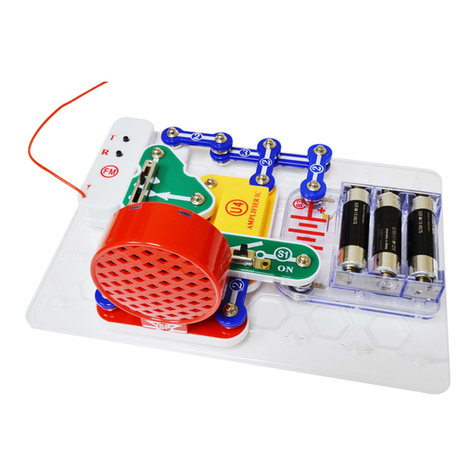
Elenco Electronics
Elenco Electronics SCP-12 User manual

Elenco Electronics
Elenco Electronics AM-780K User guide

Elenco Electronics
Elenco Electronics MX-901SW User manual

Elenco Electronics
Elenco Electronics AM/FM-108CK User guide
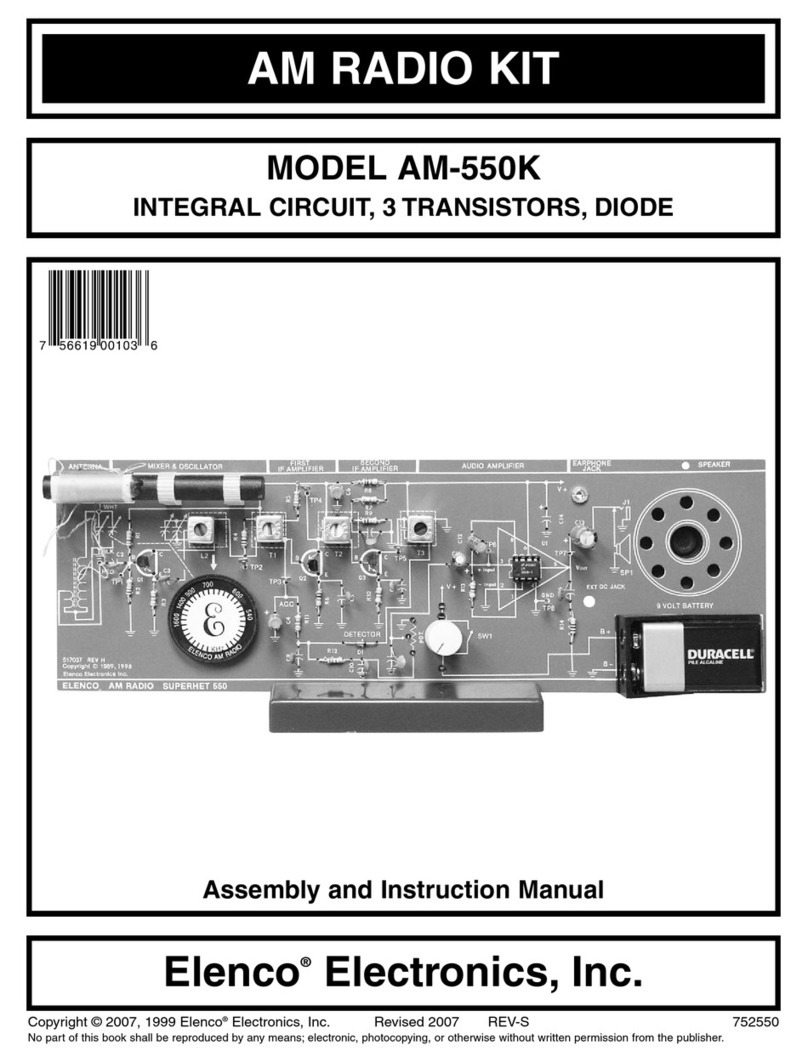
Elenco Electronics
Elenco Electronics AM-550K User guide
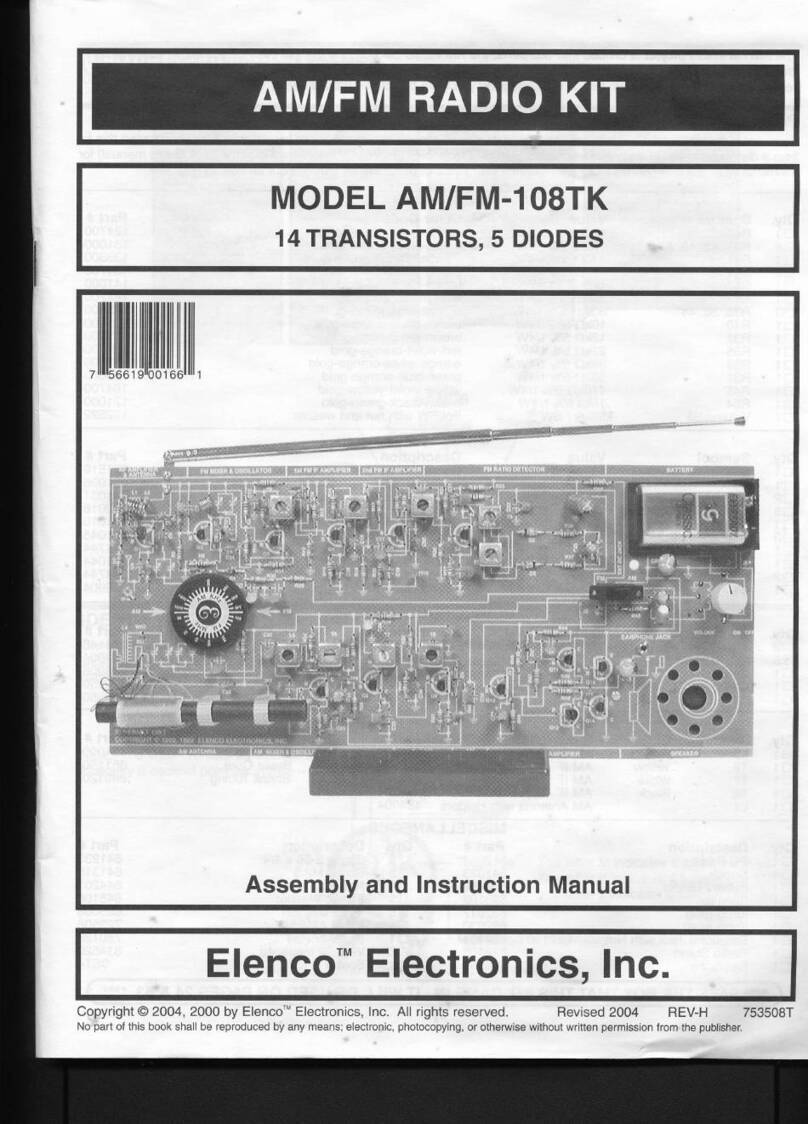
Elenco Electronics
Elenco Electronics AM/FM-108TK User manual
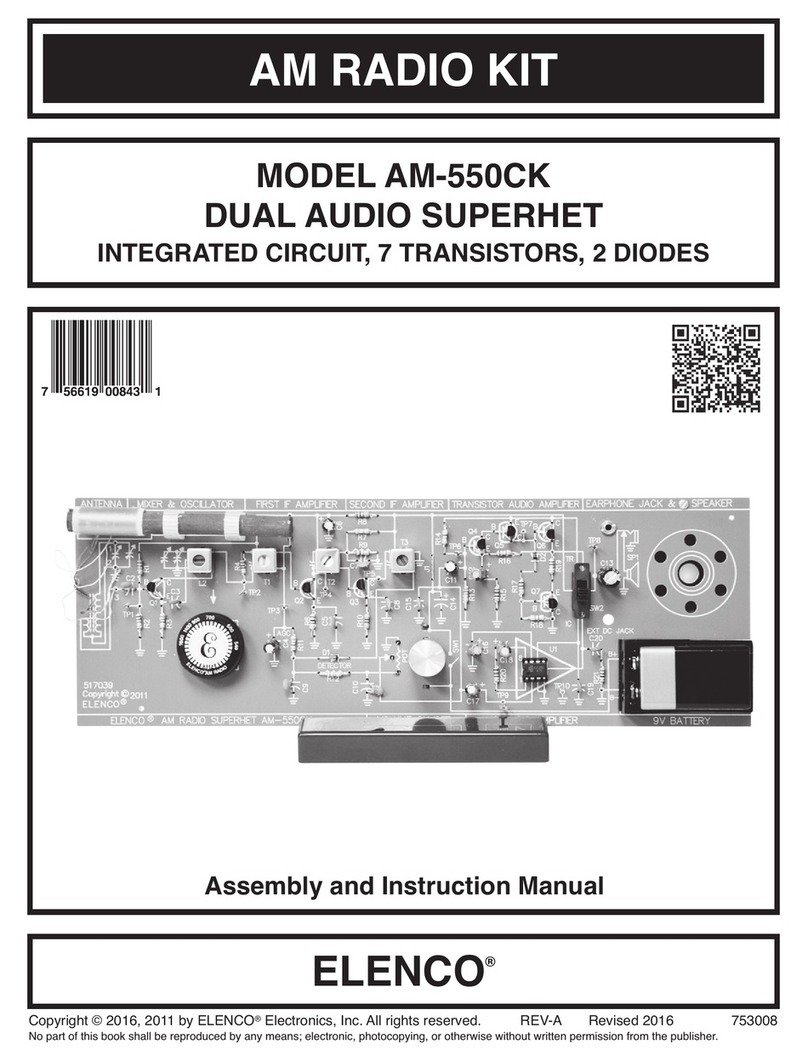
Elenco Electronics
Elenco Electronics AM-550CK User guide
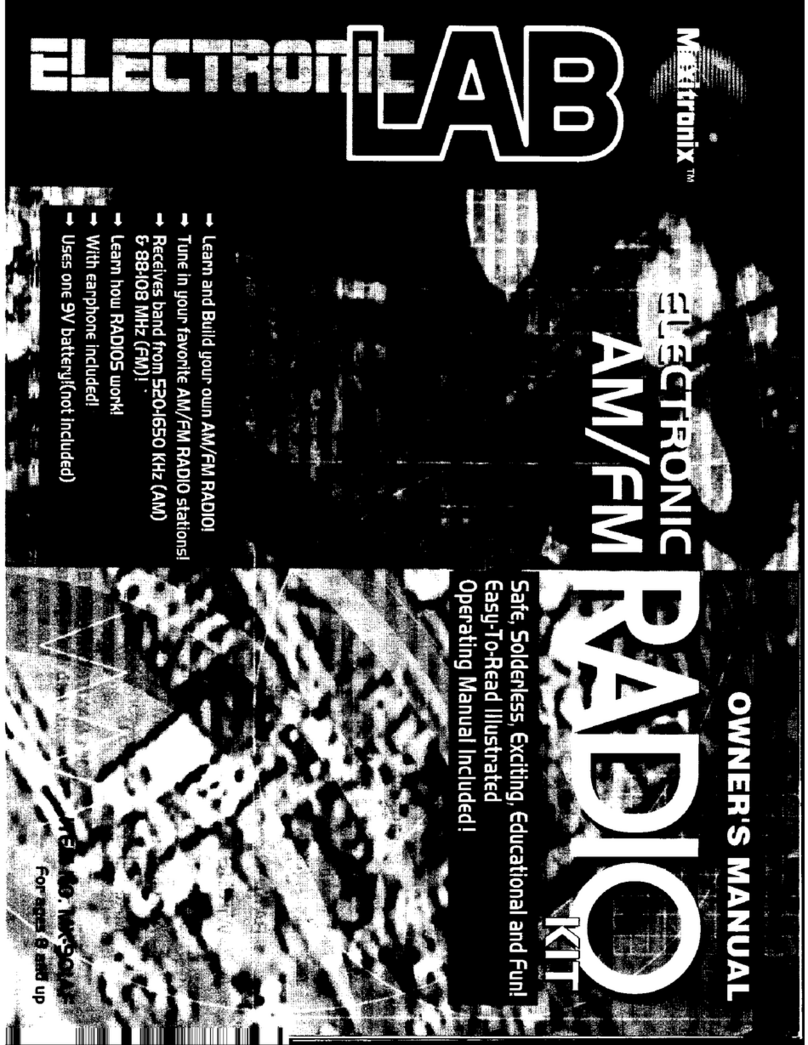
Elenco Electronics
Elenco Electronics MX-901AF User manual
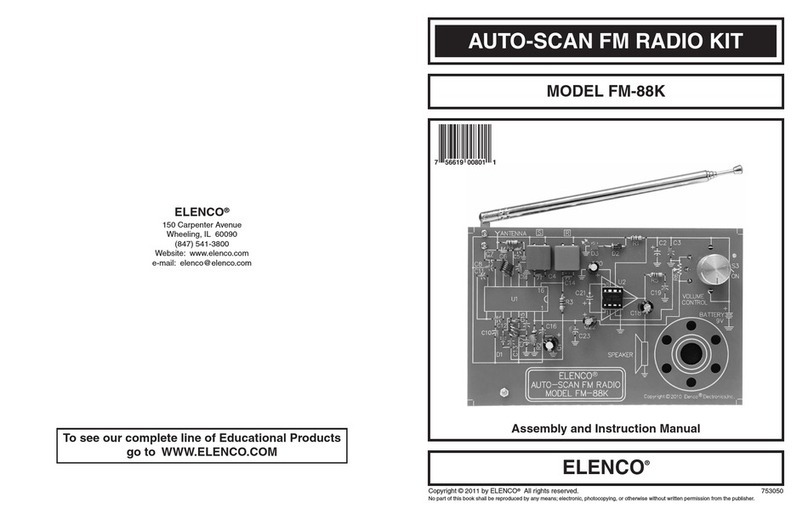
Elenco Electronics
Elenco Electronics FM-88K User guide
